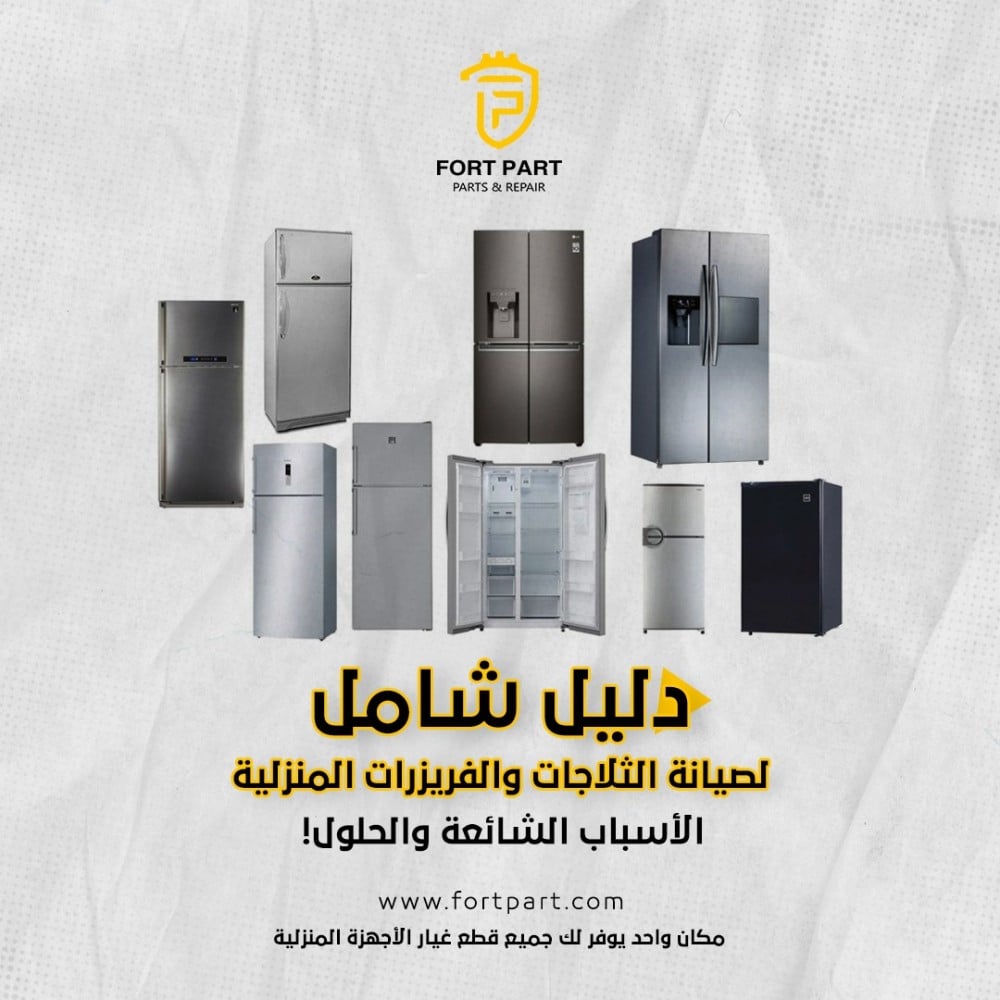When it comes to home refrigerators and freezers, you may encounter some problems that may affect their performance and ability to keep food healthy and fresh.
In this article, we will review some examples of the most important problems they may encounter and how to maintain and repair home refrigerators and freezers.
1. The refrigerator is not cooling properly:
If you notice that your refrigerator is not cooling properly, there may be several possible causes.
First, make sure the refrigerator temperature is set to the correct setting.
You may need to increase the cooling power if the temperature is too high.
Second, check that the door is tightly closed and that there is no leakage of cold air.
There may be leaks in the doors or seals that need to be replaced.
Finally, make sure that the indoor fan is working properly, if not, you may need to call a technician to fix it.
2. Water freezes in the freezer:
If there is water freezing in the freezer section, the defrost system may be faulty.
The cause may be ice buildup on the evaporator or a blockage in the defrost valve.
You can try stopping the device for a while and defrost the accumulated ice manually, but if the problem keeps recurring, you may need to call a technician to repair the system.
3. Water leaking from the refrigerator:
If you notice water leaking from your refrigerator, there may be ice buildup or a leak in the water lines.
You may need to check the water valve and hoses to make sure there are no leaks.
If there is ice buildup, you can stop the refrigerator and defrost it manually, then make sure to turn it back on to check if the problem is resolved.
4. Abnormal noise:
Refrigerators and freezers may make some normal noises during the cooling process, but if you notice abnormal or annoying noises, the appliance may be faulty.
Possible causes of the noise could be faulty moving parts, wear on the fan, or improper refrigerant pressure.
In this case, you may need to call a technician who specializes in maintaining refrigerators and freezers and making the necessary repairs.
( Whirlipool, LG, Samsung, Ariston, General Electric, Maytag, Amana, Admiral, Wessinghouse, Glem Gas, Mapei)
5. Ice accumulation in the refrigerator:
If you notice excess ice accumulating in your refrigerator, there may be a blockage in the defrost system or a faulty temperature sensor.
You may need to check the defrost valve and hot coil and make sure there is no barrier obstructing the water flow.
If the buildup continues, it is best to contact a technician for additional assistance.
To keep your refrigerator and freezer in good condition and avoid problems, you can follow some preventive measures and regular maintenance.
If you experience any problem with your refrigerator or freezer, it is best to handle it with caution according to the manufacturer's instructions.
If you are unsure of the correct procedures, it is best to contact a qualified technician to properly and safely diagnose and repair the problem.
Some tips to keep your refrigerator performing properly!
1. Clean the refrigerator regularly:
Clean your refrigerator regularly to remove dirt, stains, and unwanted odors. This helps you avoid the need to maintain your refrigerators and freezers.
Use a mild water solution and a soft cloth to clean the interior walls, shelves and seals.
Make sure the surface is completely dry before rearranging the staples.
2. Avoid opening the door frequently:
Avoid opening the door frequently or leaving it open for long periods.
Whenever you open the door, warm air from outside enters and overloads the refrigerator to cool the contents.
3. Do not exceed the recommended load:
Make sure not to exceed the recommended load for the refrigerator.
Be careful not to place large amounts of food at once, as this can affect the airflow inside the refrigerator and hinder effective cooling.
5. Avoid putting hot food in the refrigerator:
You should avoid putting hot food directly in the refrigerator.
Wait until it cools to room temperature before putting it in the refrigerator.
Placing hot food raises the temperature of the refrigerator and weakens its cooling ability.
6. Inspection and maintenance of seals:
Check the condition of the seals regularly and ensure there is no damage or air leakage.
Clean and maintain seals regularly to maintain airtight sealing and effective cooling.
7. Temperature control:
Set the refrigerator temperature according to the recommendations in the user manual.
Maintaining the right temperature helps maintain food quality and reduces energy consumption.
8. Avoid over-freezing the refrigerator:
Make sure to set the refrigerator temperature so that it is not lower than necessary.
Overfreezing the refrigerator leads to excessive energy consumption and may cause some unwanted food items to freeze.
9. Keep the refrigerator level:
Make sure the refrigerator is level and stable.
If it is not level, it may affect the refrigerator's performance and airflow properly.
10. Maintain proper ventilation:
Make sure there is enough distance between the refrigerator and the surrounding wall or furniture.
This allows air to flow freely around the refrigerator and helps in cooling it better.
11. Use energy saving mode:
If your refrigerator has an energy saving mode, it is best to use it.
This mode reduces energy consumption and maintains the refrigerator's performance effectively.
12. Avoid putting hot items in the refrigerator:
Before placing foods in the refrigerator, they must be cooled well so that the temperature inside the refrigerator does not rise and the general cooling is not affected.
13. Inspection and maintenance of internal components:
Regularly check the internal components of your refrigerator, such as fans and condensers, and make sure they are clean and working properly.
This may require the use of a qualified maintenance technician.
Recommended temperature for the refrigerator!
The recommended temperature for a refrigerator is between 2°C and 4°C (36°F to 40°F).
These ranges are considered safe for storing fresh food and maintaining its quality.
Avoid setting the temperature below this range, as it can cause food to freeze and spoil, and unnecessarily increase energy consumption.
On the other hand, avoid setting the temperature higher than the recommended range, as this increases the possibility of bacteria growth and food spoilage.
You should also consider that the temperature of the refrigerator may vary slightly in different internal parts of the refrigerator.
Therefore, it is preferable to place delicate items such as meat and fish in the cooler parts, usually located at the bottom of the refrigerator.
Other articles from Hisn Al-Qat’:
Home Appliance Maintenance Guide: How to take care of your electrical and home appliances!
Washing machine maintenance guide: How to avoid and fix problems!
Home appliance maintenance guide: Keep your appliance in good condition without malfunctions

